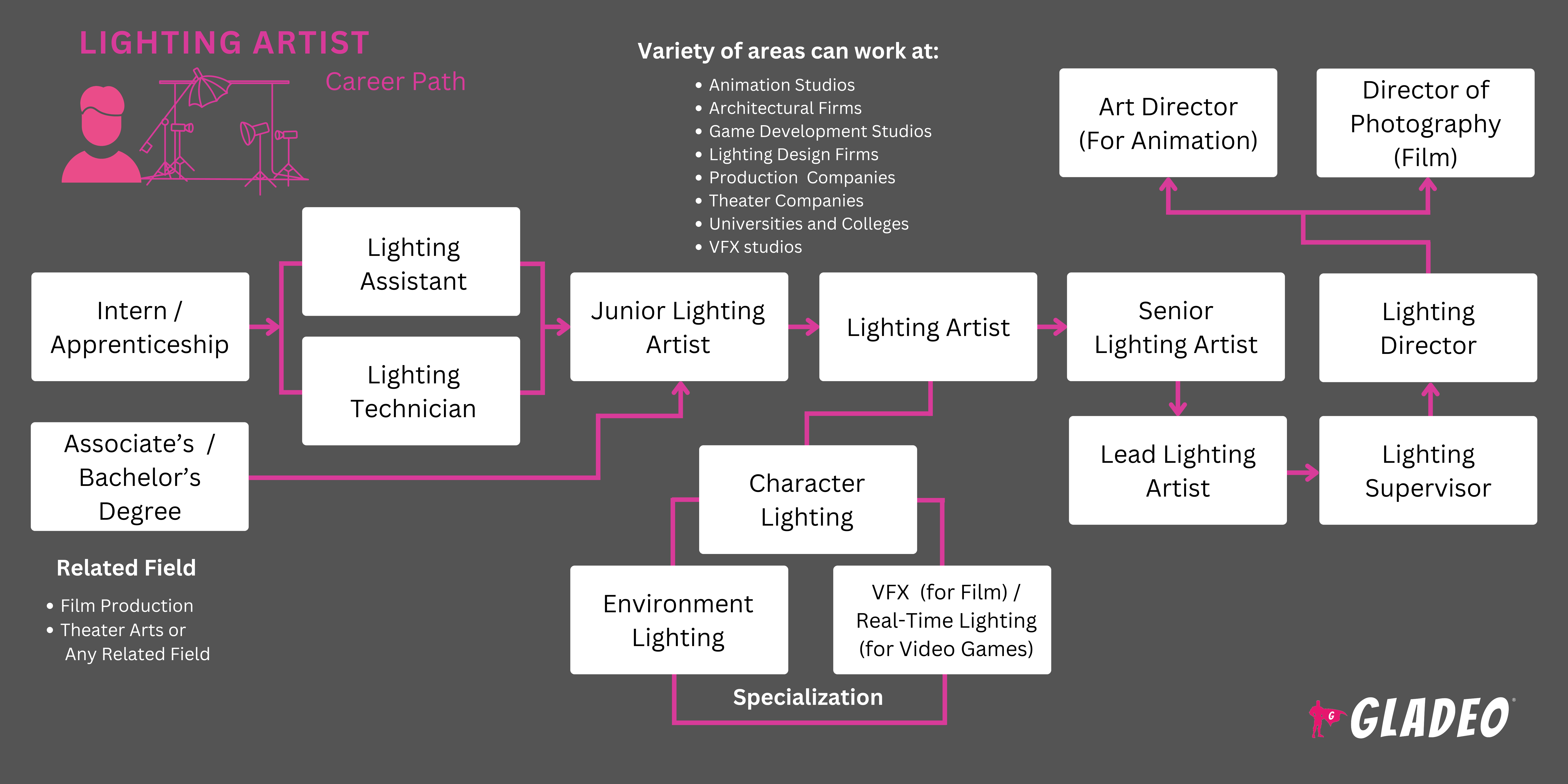Mga Spotlight
Direktor ng Teknikal na Pag-iilaw, Espesyalista sa Pag-iilaw, Superbisor ng Pag-iilaw, Kompositor ng Pag-iilaw, Artista ng Pag-iilaw at Pag-render, Artista ng Pag-iilaw at Paglililim, Artista ng Iluminasyon, CG Artista ng Pag-iilaw, Lighting TD (Direktor Teknikal), Artista ng Pag-iilaw na Biswal na Epekto
Napanood mo na ba ang pelikula o naglaro ng video game at naisip mo, “Wow, ang ganda ng ilaw!”?
Kung hindi, hindi ka lang nag-iisa. Karamihan sa mga manonood ay hindi iniisip ang lahat ng pagsisikap na ginagawa sa paglikha ng mga dinamiko at makatotohanang epekto ng pag-iilaw. Gayunpaman, kung wala ang mga epektong iyon, tiyak na mapapansin natin ang pagkakaiba! Sa pamamagitan ng malapit na pakikipagtulungan sa mga direktor, cinematographer, at iba pang mga artista, tinitiyak nilang ang pag-iilaw ay umaakma sa tono, tagpuan, aksyon, at sining ng bawat eksena.
Bagama't madalas na napapabayaan, ang mga Lighting Artist ay gumaganap ng malaking papel sa mga produksiyon ng pelikula, TV, video game, at teatro. Lumilikha at minamanipula nila ang mga epekto ng pag-iilaw upang mapahusay ang mga eksena at kapaligiran, na ginagawang mas dramatiko at kaakit-akit ang mga ito. Ito man ay pag-highlight ng ekspresyon ng mukha ng isang aktor, paglikha ng isang malungkot na kapaligiran sa gabi, o pag-highlight ng mga mananayaw sa entablado, ang kanilang mga gawa ay makikita sa halos bawat segundo ng anumang produksiyon.
- Pagpapahusay ng biswal na pagkukuwento sa pamamagitan ng mga malikhaing pamamaraan ng pag-iilaw
- Pakikipagtulungan sa iba't ibang pangkat upang makamit ang isang pinag-isang pananaw sa sining
- Nakikita ang agarang epekto ng iyong trabaho sa kalidad ng biswal ng produksyon
- Mga pagkakataong magtrabaho sa iba't ibang proyekto sa iba't ibang media
Iskedyul ng Paggawa
- Karaniwang nagtatrabaho nang full-time ang mga Lighting Artist, na may kasamang overtime upang matugunan ang mga deadline ng produksyon. Maaari silang magtrabaho sa mga studio, on-location, o sa mga sinehan. Ang ilan ay nagtatrabaho batay sa bawat proyekto.
Karaniwang mga Tungkulin
- Suriin ang mga script at storyboard upang matukoy ang mga kinakailangan sa ilaw para sa bawat eksena
- Bumuo ng mga konsepto ng pag-iilaw na naaayon sa pangkalahatang istilo at mood ng biswal
- Magbigay ng input sa mga pre-production meeting upang mabuo ang visual narrative ng proyekto
- Makipag-ugnayan sa departamento ng sining upang maisama ang mga plano sa pag-iilaw sa mga disenyo ng set at props
- Pamahalaan ang pag-setup, pagpapatakbo, at pagpapanatili ng mga kagamitan sa pag-iilaw sa set o lokasyon
- Tiyaking naka-calibrate at gumagana ang mga kagamitan sa pag-iilaw bago at habang ginagawa ang produksyon
- Ang mga karaniwang kagamitan sa pag-iilaw na ginagamit sa mga pelikula ay kinabibilangan ng mga ilaw na Fresnel, mga ilaw na Parabolic Aluminized Reflector, mga ilaw na Hydrargyrum Medium-Arc Iodide, mga LED panel, mga ilaw na tungsten, mga ilaw na Kino Flo, mga softbox, mga ilaw na Dedo, mga Century Stand, at mga reflector.
- Gumamit ng iba't ibang software program para sa mga lighting effects, lalo na para sa mga virtual production, computer-generated graphics, video games, atbp.
- Magpatupad ng mga epekto ng pag-iilaw tulad ng mga anino, highlight, at color grading
- Ayusin ang mga setup ng ilaw upang umangkop sa mga pagbabago sa mga anggulo ng kamera o pagharang sa eksena
Mga Karagdagang Responsibilidad
- Manatiling may alam tungkol sa mga umuusbong na teknolohiya at uso sa pag-iilaw
- Tiyakin ang pagsunod sa mga pamantayan at protocol sa kaligtasan
- Sanayin at gabayan ang mga junior lighting artist at technician
Mga Malambot na Kasanayan
- Kakayahang umangkop
- Pansin sa detalye
- Kalmado sa ilalim ng presyon
- Kolaboratibo
- Mga kasanayan sa komunikasyon
- Mga kasanayan sa konseptwalisasyon
- Pagkamalikhain
- Pagiging Mapagdesisyon
- Nakatuon sa detalye
- Empatiya
- Kakayahang umangkop
- Pasensya
- Pagtitiyaga
- Mga kasanayan sa paglutas ng problema
- Pagtutulungan
- Biswal na pagkukuwento
Mga Kasanayang Teknikal
- Pangunahing kaalaman sa sinematograpiya at visual effects
- Teorya ng kulay
- Mga kuha sa pag-frame at pag-stage
- Mga software na pamantayan sa industriya tulad ng Maya , Houdini , Chaos , Arnold, RenderMan , at Photoshop
- Mga real-time rendering engine tulad ng Unreal Engine
- Mga instrumento at kagamitan sa pag-iilaw tulad ng mga ilaw na Fresnel, mga ilaw na Parabolic Aluminized Reflector, mga ilaw na Hydrargyrum Medium-Arc Iodide, mga LED panel, mga ilaw na tungsten, mga ilaw na Kino Flo, mga softbox, mga ilaw na Dedo, mga Century Stand, at mga reflector
- Mga pisikal at digital na kagamitan sa pag-iilaw
- Teknikal na pag-troubleshoot sa set at sa post-production
- Pangkalahatang pag-unawa sa mga tungkulin ng iba't ibang departamento ng produksyon
- Mga kompanya ng advertising at PR
- Mga studio ng animation
- Mga kompanya ng produksyon ng pelikula at telebisyon
- Trabahong malayang trabahador o independiyente
- Mga lugar para sa pagtatanghal ng sining (teatro, konsiyerto, sayawan, eksibisyon, atbp.)
- Pagbobrodkast sa TV
- Mga studio ng video game
Ang mga Lighting Artist ay dapat gumawa ng mga ilaw na kaakit-akit sa paningin na nagpapaganda sa mga produksiyon na kadalasang napakamahal. Kaya naman, ang presyur ay dapat tiyaking magagawa nang tama ang mga bagay-bagay sa unang pagkakataon, upang maiwasan ang mga pagkaantala at mga potensyal na paglampas sa gastos.
Bukod pa rito, ang mga Lighting Artist ay kadalasang nagtatrabaho sa mga mapaghamong kapaligiran tulad ng mga lokasyon sa labas, kung saan kailangan nilang umangkop sa pabago-bagong panahon at natural na liwanag. Kailangan nilang manatiling flexible sakaling magkaroon ng mga huling minutong pagbabago na nangangailangan ng pagsasaayos ng mga setup ng ilaw.
Napakahalaga ng epektibong kolaborasyon dahil ang mga Lighting Artist ay kailangang makipag-ugnayan sa iba't ibang departamento, kabilang ang sinematograpiya, direksyon ng sining, at post-production, upang matiyak ang isang magkakaugnay na visual aesthetic. Ang trabaho ay maaaring maging mahirap paminsan-minsan, na may mahahabang oras at pressure na matugunan ang mga deadline. Ngunit ang mga gantimpala ng pagtingin sa iyong trabaho sa screen o entablado ay maaaring maging lubos na kasiya-siya!
Sa loob ng industriya ng pag-iilaw, mayroong mas mataas na pokus sa pagpapanatili at mga kasanayan sa pag-iilaw na eco-friendly, tulad ng mga opsyon sa LED na nagbabawas sa pagkonsumo ng enerhiya at epekto sa kapaligiran. Mas karaniwan din ang mga pamamaraan ng digital lighting at virtual production , na nagbibigay-daan sa mga Lighting Artist na lumikha ng mga dynamic at flexible na setup sa mga CGI na kapaligiran. Bukod pa rito, ang pagsasama ng pag-iilaw sa iba pang mga visual effect tulad ng augmented at virtual reality ay nagtutulak sa mga hangganan ng kung ano ang maaaring makamit sa visual storytelling!
Noong bata pa sila, maaaring nasiyahan ang mga Lighting Artist sa potograpiya at pag-eeksperimento sa liwanag at mga anino. Maaaring lumahok din sila sa mga produksiyon sa teatro, tumulong sa mga ilaw sa entablado o iba pang pag-setup.
- Ang mga Lighting Artist ay kadalasang kumukuha ng bachelor's degree sa produksyon ng pelikula, sining sa teatro, o isang kaugnay na larangan.
- Maaaring kabilang sa mga kaugnay na gawain ang:
- 3D na Pag-iilaw at Pag-render
- Sinematograpiya
- Teorya ng kulay
- Software para sa digital na pag-iilaw
- Interaktibong Pag-iilaw sa Virtual na Produksyon
- Liwanag at Anino sa Pagkukuwentong Biswal
- Pag-iilaw para sa Animasyon
- Pag-iilaw para sa Green Screen at Compositing
- Pag-iilaw para sa High Dynamic Range (HDR) Imaging
- Pagsusuring Potometriko para sa Pelikula at Teatro
- Disenyo ng Set at Pagsasama ng Ilaw
- Disenyo ng Ilaw sa Entablado
- Tandaan, ang isang degree sa kolehiyo ay hindi palaging isang mahigpit na kinakailangan para maging isang Lighting Artist. Marami ang naging kwalipikado para sa kanilang trabaho sa pamamagitan ng mga alternatibong paraan tulad ng:
- Pagsasanay habang nagtatrabaho, simula bilang isang assistant o lighting technician
- Mga apprenticeship na nagtatrabaho sa ilalim ng mga bihasang Lighting Designer o Gaffer
- Mga workshop at maikling kurso na nakatuon sa pag-iilaw para sa pelikula
- Pag-aaral sa sarili at pagsasanay gamit ang mga online na mapagkukunan at mga tutorial
- Trabahong freelance sa maliliit na independiyenteng proyekto
- Mga sertipikasyon sa software at kagamitan sa pag-iilaw tulad ng mga kredensyal sa Autodesk Maya, Houdini, Chaos, Arnold, Unreal Engine, mga lighting console tulad ng Eos ng ETC o GrandMA ng MA Lighting , o DaVinci Resolve
- Kabilang sa mga karagdagang sertipikasyon ang:
- Pandaigdigang Asosasyon ng mga Disenyador ng Ilaw - Sertipikadong Disenyador ng Ilaw
- International Alliance of Theatrical Stage Employees - Sertipikadong Film Lighting Technician
- Unreal Engine - Sertipikasyon sa Pag-iilaw ng Virtual na Produksyon
- Unity Technologies - Sertipikasyon sa Real-Time na Pag-iilaw para sa mga Video Game
- Isaalang-alang ang halaga ng matrikula, mga diskwento, at mga lokal na pagkakataon sa scholarship (bilang karagdagan sa pederal na tulong).
- Isipin ang iyong iskedyul at ang iyong kakayahang umangkop kapag nagpapasya kung mag-e-enroll sa isang on-campus, online, o hybrid na programa. Sa isip, gugustuhin mo ang mas maraming praktikal na pagsasanay hangga't maaari.
- Tingnan ang mga nagawa ng mga guro sa programa upang makita kung anong mga proyekto ang kanilang pinagtrabahuhan.
- Suriing mabuti ang mga pasilidad ng paaralan at ang mga kagamitan at software na ginagamit sa pagsasanay ng mga estudyante.
- Tingnan kung ang programa ay nag-aalok ng mga pagkakataon para sa praktikal na pag-aaral sa pamamagitan ng mga internship o kooperatibong edukasyon sa mga kumpanya ng produksyon.
- Suriin ang mga istatistika ng pagkakalagay sa trabaho at mga detalye tungkol sa alumni network ng programa.
- Kumuha ng mga kurso sa disenyo ng ilaw, sinematograpiya, potograpiya, at digital lighting software
- Magkaroon ng karanasan sa pamamagitan ng mga internship o part-time na trabaho sa pelikula, TV, o produksiyon sa teatro na nakatuon sa pag-iilaw
- Gumawa ng portfolio o demo reel ng iyong trabaho, kabilang ang mga lighting setup at disenyo mula sa iba't ibang proyekto
- Manatiling may alam tungkol sa mga kasalukuyang uso sa pag-iilaw ng pelikula at mga visual effect
- Dumalo sa mga film festival, mga workshop sa pag-iilaw, at mga kaganapan sa industriya. Makipag-network sa mga propesyonal sa industriya ng pag-iilaw at sinematograpiya. Sumali sa mga propesyonal na organisasyon para sa mga lighting artist
- Sumali sa mga audiovisual club o magboluntaryo para sa mga palabas sa teatro sa paaralan o komunidad upang makakuha ng karanasan sa pag-iilaw. Maghanap ng isang tagapayo na maaaring gumabay sa iyo sa mga pagpili ng edukasyon at pagsasanay.
Simulan ang paggawa sa maliliit na proyekto ng pelikula, na nakatuon sa disenyo ng ilaw, at ibahagi ang mga ito sa mga platform tulad ng YouTube o Vimeo - Mag-aral ng mga libro, artikulo, at mga video tutorial na may kaugnayan sa disenyo ng ilaw at sinematograpiya (tingnan ang aming listahan ng mga Mapagkukunan > Mga Website)
- Kilalanin ang mga pangunahing departamento ng mga produksiyon ng pelikula upang maunawaan kung paano nakikipag-ugnayan ang ilaw sa iba pang mga elemento
- Manood ng mga pelikula at mga video sa likod ng mga eksena. Pag-aralan ang paggamit ng ilaw, mga epekto, at paggamit ng kamera
- Magtala ng mga pamamaraan na ginagamit sa iba't ibang genre at eksena
- Humiram o umarkila ng mga kagamitan sa pag-iilaw upang makakuha ng praktikal na karanasan at mag-eksperimento sa iba't ibang mga setup
- Maging pamilyar sa software sa pag-edit ng video at kung paano nakakaapekto ang mga pagpipilian sa ilaw sa post-production
- I-advertise ang iyong mga freelance na serbisyo sa pag-iilaw sa lokal na lugar o online upang makakuha ng karanasan
- Mag-apply para sa mga internship sa pelikula at teatro na nakatuon sa disenyo ng ilaw hanggang sa mapili mo ang isa

- Gumamit ng mga job portal tulad ng Indeed at mga website na partikular sa industriya tulad ng Staff Me Up para makahanap ng mga oportunidad
- Maghanda ng isang matibay na portfolio, demo reel , at resume upang itampok ang iyong mga kasanayan at karanasan
- Suriin ang mga template ng resume ng Lighting Artist para makakuha ng mga ideya para sa pag-format at pagbigkas
- Pansinin ang mga keyword na ginagamit sa mga job posting at subukang isama ang mga ito sa iyong resume. Maaaring kabilang sa mga keyword ang:
- Pagmamarka ng Kulay
- Pag-composite
- Disenyo ng Pag-iilaw
- Pag-iilaw ng Mood
- Photorealistic
- Pag-render
- Pag-optimize ng Eksena
- Paglililim
- Mga Epektong Biswal
- Gamitin ang mga serbisyo sa karera ng iyong paaralan para sa tulong sa paghahanap ng trabaho, pagsulat ng resume, at pakikipanayam
- Tanungin ang iyong programa kung mayroon silang mga koneksyon sa industriya na maaaring makatulong sa iyo
- Ipaalam sa iyong network na naghahanap ka ng trabaho o internship, dahil maraming oportunidad ang napupunan sa pamamagitan ng personal at propesyonal na mga koneksyon.
- Makilahok sa mga kumperensya at expo sa industriya upang ipakita ang iyong mga gawa
- Malamang na kakailanganin mong mag-apply para sa mga entry-level na trabaho at umasenso sa mas matataas na posisyon. Maraming Lighting Artist ang nagsisimula bilang mga assistant o intern.
- Buuin ang iyong reputasyon at tiyaking makikita ang iyong mga gawa sa pamamagitan ng pagsali sa mga film festival, pag-promote ng iyong mga gawa sa social media, at pagpapalathala sa mga journal sa industriya o sa mga sikat na website.
- Lumipat sa kung saan pinakamaraming trabaho sa pelikula at TV, tulad ng California, New York, Texas, Florida, at Georgia
- Pumunta sa mga forum at magsimulang magtanong ng mga payo sa trabaho at humingi ng mga sagot mula sa mga nagtatrabahong propesyonal
- Tanungin ang iyong mga propesor, superbisor, at mga kasamahan kung maaari silang magsilbing personal na sanggunian
- Mga tanong sa panayam sa pag-aaral tulad ng “ Paano mo nilalapitan ang paglikha ng ilaw na nagpapahusay sa mood at atmospera ng isang eksena habang pinapanatili ang visual consistency sa maraming kuha ?” o “ Maaari mo bang ilarawan ang isang mapanghamong proyekto kung saan kinailangan mong malikhaing lutasin ang isang isyu sa ilaw? Ano ang problema, at paano mo ito tinugunan? ”
- Palaging manamit nang naaayon para sa tagumpay sa job interview
- Patuloy na naghahatid ng makabago at de-kalidad na mga epekto ng pag-iilaw
- Humingi ng karagdagang pagsasanay at sertipikasyon sa software at kagamitan sa pag-iilaw tulad ng mga kredensyal sa Autodesk Maya, Houdini, Chaos, Arnold, Unreal Engine, mga lighting console tulad ng EOS ng ETC o GrandMA ng MA Lighting, o DaVinci Resolve
- Kabilang sa mga karagdagang sertipikasyon ang:
- Pandaigdigang Asosasyon ng mga Disenyador ng Ilaw - Sertipikadong Disenyador ng Ilaw
- International Alliance of Theatrical Stage Employees - Sertipikadong Film Lighting Technician
- Unreal Engine - Sertipikasyon sa Pag-iilaw ng Virtual na Produksyon
- Unity Technologies - Sertipikasyon sa Real-Time na Pag-iilaw para sa mga Video Game
- Makilahok sa mga kumperensya at kaganapan sa industriya upang makakuha ng pagkakalantad
- Bumuo ng online presence para i-market ang iyong trabaho
- Patuloy na matuto nang higit pa tungkol sa mga tungkulin ng iba
- Tratuhin ang mga tao nang may respeto, laging maging handa, at manatiling kalmado sa ilalim ng pressure
- Manood at matuto mula sa mas nakatatandang Lighting Artists. Makinig din sa mga assistant director, department lead, at crew members!
- Sanayin at gabayan ang mga bagong kawani upang sila ay lumago nang propesyonal
- Sumali sa mga propesyonal na organisasyon at sikaping manalo ng mga parangal o pagkilala
Mga Organisasyong Propesyonal
- Samahang Amerikano ng mga Sinematograpo
- Pandaigdigang Alyansa ng mga Empleyado sa Entablado ng Teatro
- Samahan ng mga Epektong Biswal
Mga Institusyong Pang-edukasyon
- Institusyon ng Pelikulang Amerikano
- Kolehiyo ng Komunikasyon ng Unibersidad ng Boston
- Kolehiyo ng Pelikula at Sining ng Media ng Chapman University sa Dodge
- Kolehiyo ng Sining ng Pelikula sa Unibersidad ng Estado ng Florida
- Unibersidad ng Buong Paglalayag
- Paaralan ng Pelikula sa LA
- Paaralan ng Pelikula at Telebisyon ng Loyola Marymount University
- Akademya ng Pelikula ng New York
- Paaralan ng Sining ng NYU/Tisch
- Paaralan ng Teatro, Telebisyon at Pelikula ng San Diego State University
- Instituto ng Pelikula ng Seattle
- Paaralan ng Teatro, Pelikula at Telebisyon ng UCLA
- Kagawaran ng Radyo, Telebisyon at Pelikula ng Unibersidad ng Texas sa Austin
- Paaralan ng Sining sa Sine ng USC
Mga Website
- Aksyon-Paggupit-Pag-print
- Adorama
- Network ng Mundo ng Animasyon
- B&H Larawan, Bidyo, at Pro Audio
- Cinephilia at Higit Pa
- DVXuser
- Kolaborasyon ng Pelikula
- IQ ng Gumagawa ng Pelikula
- Magasin ng Gumagawa ng Pelikula
- Kaguluhan sa Pelikula
- Mga Tinanggihan ng Paaralan ng Pelikula
- Paghahanap ng Pelikula
- Gabay sa FX
- Sining at Kultura ng Google
- Hollywood OmniBook
- Pagsisiksikan sa Pelikulang Indie
- IndieTalk
- Indiewire
- Pag-iilaw at Tunog Amerika
- Pambansang Kalooban para sa Sining
- Walang Paaralan ng Pelikula
- ProductionHUB
- Koalisyon ng ProVideo
- Magasin ng Iskrip
- Pamamaril sa mga Tao
- Mga Mag-aaral na Gumagawa ng Pelikula
- Studio Araw-araw
- Database ng Ilaw sa Sinehan
- VFX na Boses
- Videomaker
Software
Mga Libro
- Pagdidisenyo Gamit ang Liwanag , ni J. Michael Gillette
- Pag-iilaw ng Pelikula: Mga Pakikipag-usap sa mga Sinematograpo at Gaffer ng Hollywood , ni Kris Malkiewicz
- Pag-iilaw para sa Sinematograpiya , ni David Landau
- Handbook ng Set Lighting Technician , ni Harry C. Box
- Ang Handbook ng Pag-iilaw sa Entablado , ni Francis Reid
Ang pag-iilaw ay mas kumplikado kaysa sa inaakala ng maraming tao, at ang larangan ay mabilis na umuunlad habang ang paggawa ng pelikula ay nagiging mas digital at ang mga video game ay nagiging mas makatotohanan. Ito ay isang dinamiko at mapanghamong larangan ng karera, ngunit tulad ng anumang trabaho, hindi ito perpektong akma para sa lahat. Kung interesado ka sa ilang alternatibong karera, isaalang-alang ang mga kaugnay na tungkulin tulad ng:
- Animator
- Ilustrador ng Arkitektura
- Direktor ng Sining
- Operator ng Kamera
- Ilustrador ng Aklat Pambata
- Koreograpo
- Sinematograpo
- Komiksista
- Disenyador ng Ilaw na Pangkomersyo
- Sketch Artist sa Korte
- Ilustrador ng Moda
- Editor ng Pelikula at Video
- Mahusay na Artista
- Gaffer
- Disenyador ng Grapiko
- Ilustrador
- Medikal na Ilustrador
- Disenyador ng Ilaw sa Bahay
- Tagadisenyo ng Set
- Taga-disenyo ng Tunog
- Artista ng Espesyal na Epekto
- Tagapamahala ng Entablado
- Artista ng Storyboard
- Artista ng Tattoo
- Teknikal na Ilustrador
- Manunulat
Balita

Mga Itinatampok na Trabaho

Mga Online na Kurso at Kagamitan








